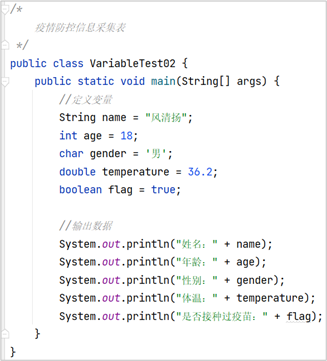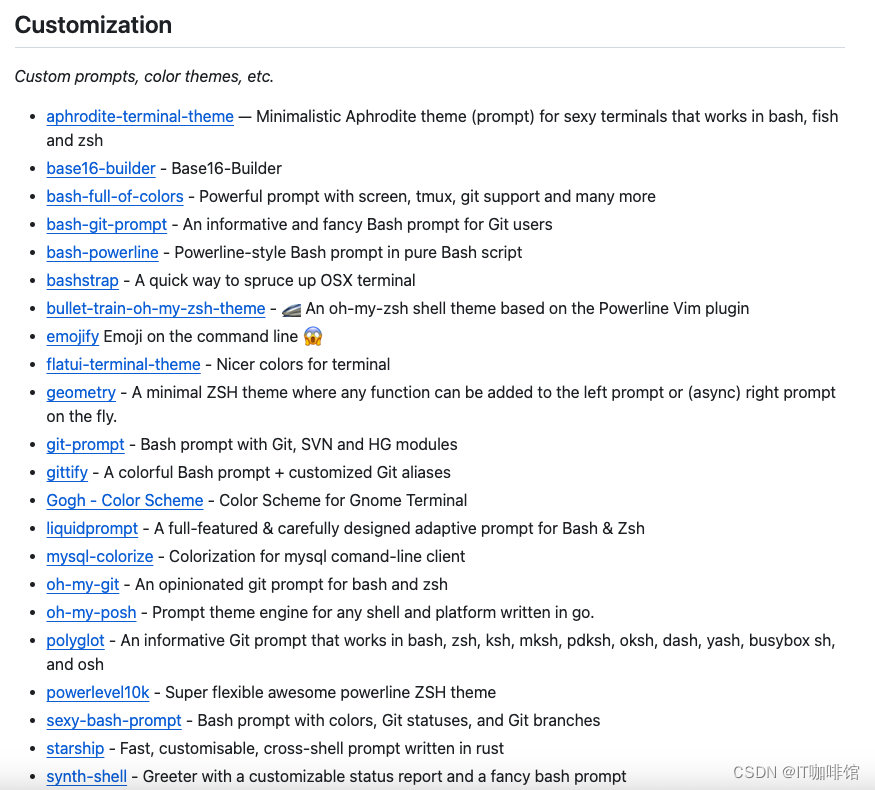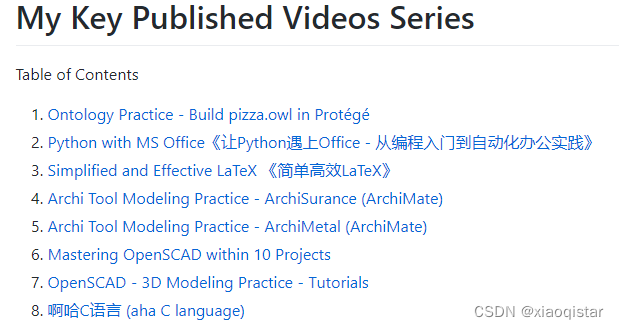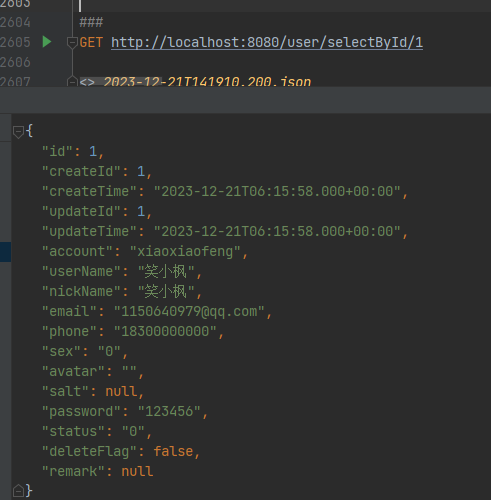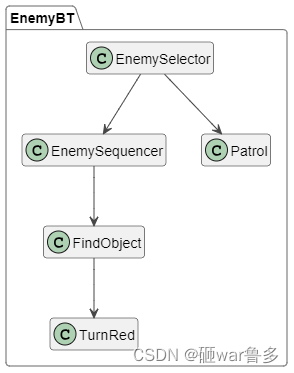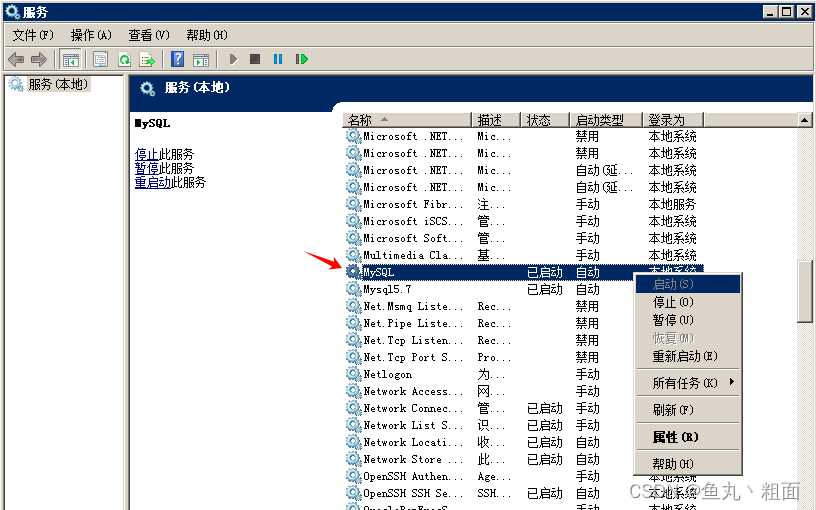目录
(一) 线性表
(二) ArrayList
1. ArrayList的介绍
2. ArrayList的常见方法和使用
3. ArrayList的遍历
4. ArrayList的模拟实现
5. ArrayList的优缺点
(三) LinkedList
1. LinkedList的介绍
2. LinkedList的常见方法和使用
3. LinkedList的遍历
4. LinkedList的模拟实现
5. LinkedList的优缺点
(四) ArrayList和LinkedList的区别
总结

(一) 线性表
线性表(linear list)是n个具有相同特性的数据元素的有限序列。 线性表是一种在实际中广泛使用的数据结 构,常见的线性表:顺序表、链表、栈、队列...
线性表在逻辑上是线性结构,也就说是连续的一条直线。但是在物理结构上并不一定是连续的,线性表在物 理上存储时,通常以数组和链式结构的形式存储。如下图:
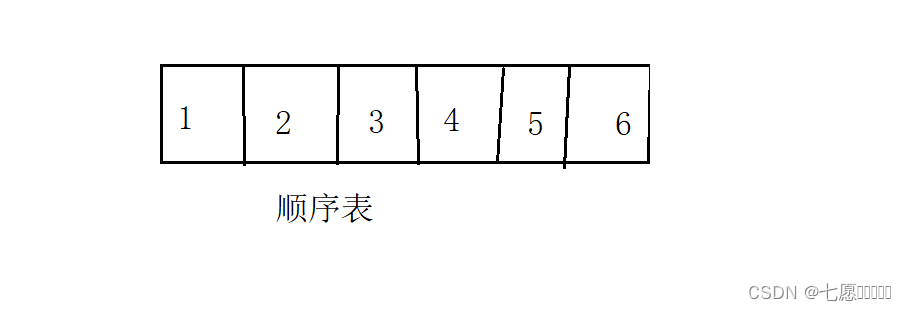

(二) ArrayList
1. ArrayList的介绍
ArrayList是Java中的一个动态数组类, 即顺序表,可以动态地增加或减少数组的大小。它是一个可以动态改变大小的数组,可以根据需要自动地增加或减少数组的大小。ArrayList可以存储任意类型的对象,包括基本数据类型和引用类型, 它实现了List接口, 具体框架图如下:

[说明]
1. ArrayList实现了RandomAccess接口,表明ArrayList支持随机访问
2. ArrayList实现了Cloneable接口,表明ArrayList是可以clone的
3. ArrayList实现了Serializable接口,表明ArrayList是支持序列化的
4. 和Vector不同,ArrayList不是线程安全的,在单线程下可以使用,在多线程中可以选择Vector或者 CopyOnWriteArrayList
5. ArrayList底层是一段连续的空间,并且可以动态扩容,是一个动态类型的顺序表
2. ArrayList的常见方法和使用
使用ArrayList可以方便地进行元素的添加、删除和查找操作,是Java中常用的集合类之一。
ArrayList类包含许多常用的方法,以下是一些常见的方法和它们的使用:
常见的方法
- boolean add(E e):向ArrayList中尾插 一个元素e。
- void add(int index, E element): 将 e 插入到 index 位置
- E remove(int index):移除指定索引位置的元素。
- E get(int index):获取指定索引位置的元素。
- size():获取ArrayList的大小
- E set(int index, E element): 将下标 index 位置元素设置为 element
- void clear(): 清空
- boolean contains(Object o):判断ArrayList是否包含指定的元素。
- int indexOf(Object o):返回指定元素在ArrayList中第一次出现的索引。
- int lastIndexOf(Object o): 返回指定元素在ArrayList中最后一次出现的索引。
使用:
import java.util.ArrayList;
public class ArrayListExample {
public static void main(String[] args) {
// 创建一个ArrayList
ArrayList<String> list = new ArrayList<>();
// 向ArrayList中尾插元素
list.add("apple");
list.add("banana");
list.add("orange");
// 将元素插入到指定索引位置
list.add(1, "grape");
//遍历ArrayList
System.out.print("打印1: ");
for (String ret: list) {
System.out.print(ret+" ");
}
System.out.println();
// 移除指定索引位置的元素
list.remove(2);
//遍历ArrayList
System.out.print("打印2: ");
for (String ret: list) {
System.out.print(ret+" ");
}
System.out.println();
// 获取指定索引位置的元素
String fruit = list.get(0);
System.out.println("索引0处的水果: " + fruit);
// 获取ArrayList的大小
int size = list.size();
System.out.println("ArrayList的大小: " + size);
// 将指定索引位置的元素设置为新元素
list.set(2, "cherry");
// 判断ArrayList是否包含指定的元素
boolean contains = list.contains("apple");
System.out.println("是否包含'apple': " + contains);
// 返回指定元素在ArrayList中第一次出现的索引
int index = list.indexOf("banana");
System.out.println("'banana'第一次出现的索引: " + index);
// 返回指定元素在ArrayList中最后一次出现的索引
int lastIndex = list.lastIndexOf("apple");
System.out.println("'apple'最后一次出现的索引: " + lastIndex);
// 清空ArrayList
list.clear();
//遍历ArrayList
System.out.print("打印3: ");
for (String ret: list) {
System.out.print(ret+" ");
}
System.out.println();
}
}
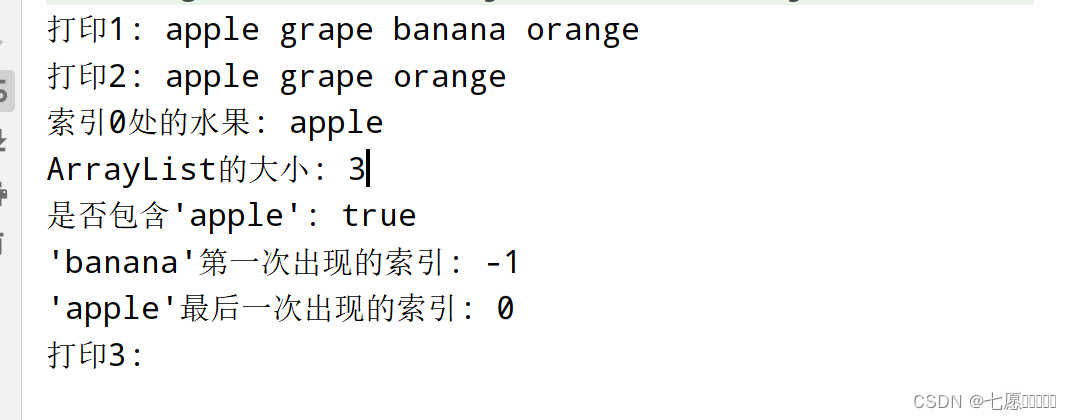
3. ArrayList的遍历
ArrayList可以使用三种方式遍历:for循环+下标、foreach、使用迭代器, 代码如下:
import java.util.ArrayList;
public class ArrayListExample {
public static void main(String[] args) {
// 创建一个ArrayList对象,它是List接口的实现类
List<String> list = new ArrayList<>();
// 将指定的元素添加到列表的末尾
list.add("apple");
list.add("banana");
list.add("cherry");
//for循环+下标
System.out.print("for循环+下标: ");
for (int i = 0; i < list.size(); i++) {
System.out.print(list.get(i)+" ");
}
System.out.println();
//foreach遍历
System.out.print("foreach遍历: ");
for (String ret : list) {
System.out.print(ret+" ");
}
System.out.println();
//使用迭代器
System.out.print("迭代器遍历: ");
Iterator<String> iter = list.iterator();
while (iter.hasNext()){
String ret = iter.next();
System.out.print(ret+" ");
}
System.out.println();
}
}
4. ArrayList的模拟实现
package List;
import java.util.Arrays;
// 自定义的ArrayList类
public class MyArrayList {
public int[] arr; // 用于存储元素的数组
public int size; // 记录当前数组中的元素个数
public static final int Max = 10; // 默认最大容量
// 构造方法,初始化数组
public MyArrayList() {
this.arr = new int[10];
}
// 打印元素
public void display() {
for (int i = 0; i < this.size; i++) {
System.out.print(arr[i] + " ");
}
System.out.println();
}
// 增加元素
public void add(int data) {
if (isFull()) {
arr = Arrays.copyOf(arr, arr.length * 2); // 如果数组已满,扩容为原来的两倍
}
arr[size++] = data;
}
// 判断数组是否已满
public boolean isFull() {
if (size == Max) {
return true;
}
return false;
}
// 检查插入位置是否合法
private void checkAddPos(int pos) {
if (pos < 0 || pos > size) {
throw new PosIndexNotLegalException("pos位置不合法");
}
}
// 在指定位置插入元素
public void add(int pos, int data) {
try {
checkAddPos(pos);
if (isFull()) {
arr = Arrays.copyOf(arr, 2 * arr.length); // 如果数组已满,扩容为原来的两倍
}
for (int i = size - 1; i >= pos; i--) {
arr[i + 1] = arr[i]; // 元素后移
}
arr[pos] = data; // 在指定位置插入新元素
size++;
} catch (PosIndexNotLegalException e) {
e.printStackTrace();
}
}
// 判断是否包含某个元素
public boolean contains(int toFind) {
for (int i = 0; i < size; i++) {
if (arr[i] == toFind) {
return true;
}
}
return false;
}
// 查找某个元素对应的位置
public int indexOf(int toFind) {
for (int i = 0; i < size; i++) {
if (arr[i] == toFind) {
return i;
}
}
return -1; // 如果找不到返回-1
}
// 获取指定位置的元素
public int get(int pos) {
checkAddPos(pos);
return arr[pos];
}
// 给指定位置的元素赋值
public void set(int pos, int value) {
checkAddPos(pos);
arr[pos] = value;
}
// 删除第一次出现的指定元素
public void remove(int toRemove) {
int index = indexOf(toRemove);
if (index == -1) {
System.out.println("没有你要删除的数字!");
return;
}
for (int j = index; j < size; j++) {
arr[j] = arr[j + 1]; // 元素前移
}
size--;
}
// 获取顺序表长度
public int size() {
int ret = size;
return ret;
}
// 清空顺序表
public void clear() {
size = 0; // 将元素个数置为0,实现清空操作
}
}
5. ArrayList的优缺点
优点:
- 随机访问:由于 ArrayList 使用数组来存储元素,可以通过索引快速访问元素,性能较好,时间复杂度为 O(1)。
- 灵活的大小:ArrayList 的大小可以动态调整,不需要预先指定数组大小,可以根据需求动态增加或减少元素。
缺点:
- 插入和删除效率低:在 ArrayList 中间或开头插入或删除元素时,需要移动后续元素,时间复杂度为 O(n),性能较差。
- 内存开销:ArrayList 在动态扩容时需要重新分配内存并拷贝元素,可能会产生额外的内存开销。
总结
ArrayList 适合需要频繁随机访问元素、对大小变化较为频繁的场景,但在大量插入和删除操作时性能较差。
(三) LinkedList
1. LinkedList的介绍
在前面ArrayList我们知道,当在ArrayList任意位置插入或者删除元素时,就需要将后序元素整体往前或者往后搬移,时间复杂度为O(n),效率比较低,因此ArrayList不适合做任意位置插入和删除比较多的场景。因此:java 集合中又引入了LinkedList,即链表结构。
LinkedList 是 Java 中的一个无头双向链表。实现,实现了 List 和 Deque 接口,LinkedList 内部是使用无头双向循环链表。表来存储元素,每个节点包含对前一个节点和后一个节点的引用。LinkedList 支持在任意位置进行高效的插入和删除操作,时间复杂度为 O(1)。无头双向链表结构图:

双向链表的每个节点都有 3 个属性:
-
data : 实际存放的内容;
-
prev : 指向前一节点的指针;
-
next : 指向后一节点的指针。
实际中链表的结构非常多样,单向或者双向, 带头或者不带头, 循环或者非循环
虽然有这么多的链表的结构,但是我们重点掌握两种:
无头单向非循环链表:结构简单,一般不会单独用来存数据。实际中更多是作为其他数据结构的子结构,如 哈希桶、图的邻接表等等。另外这种结构在笔试面试中出现很多。
无头双向链表:在Java的集合框架库中LinkedList底层实现就是无头双向循环链表。
2. LinkedList的常见方法和使用
LinkedList 类实现了 List 接口,因此它包含了 List 接口定义的所有方法,例如 add、remove、get、set 等。此外,LinkedList 还包含了一些特有的方法,如 addFirst、addLast等,用于在链表的开头或结尾进行操作
常见方法
- boolean add(E e): 在链表的末尾添加元素。
- void addFirst(E e): 在链表的开头添加元素。
- void addLast(E e): 在链表的末尾添加元素。
- E get(int index): 获取指定位置的元素。
- E set(int index, E element) 将下标 index 位置元素设置为 element
- boolean remove(): 删除并返回链表的第一个元素。
- String removeFirst(): 删除并返回链表的第一个元素。
- String removeLast(): 删除并返回链表的最后一个元素。
- int size(): 获取链表的大小。
- boolean contains(Object o): 判断链表是否包含指定的元素。
- int indexOf(Object o): 返回指定元素在链表中第一次出现的位置。
- int lastIndexOf(Object o) 返回最后一个 o 的下标
- void clear() 清空
import java.util.LinkedList;
class Main {
public static void main(String[] args) {
LinkedList<String> linkedList = new LinkedList<>();
// 添加元素
linkedList.add("A");
System.out.println("添加 'A' 后的链表: " + linkedList);
linkedList.addFirst("B");
System.out.println("在链表开头添加 'B' 后的链表: " + linkedList);
linkedList.addLast("C");
System.out.println("在链表末尾添加 'C' 后的链表: " + linkedList);
// 获取元素
String elementAtIndex1 = linkedList.get(1);
System.out.println("索引为 1 的元素: " + elementAtIndex1);
// 设置元素
linkedList.set(0, "D");
System.out.println("将索引为 0 的元素设置为 'D' 后的链表: " + linkedList);
// 删除元素
String removedElement = linkedList.remove();
System.out.println("删除的元素: " + removedElement);
String removedFirst = linkedList.removeFirst();
System.out.println("删除的第一个元素: " + removedFirst);
String removedLast = linkedList.removeLast();
System.out.println("删除的最后一个元素: " + removedLast);
// 获取链表大小
int size = linkedList.size();
System.out.println("链表的大小: " + size);
// 判断是否包含元素
boolean contains = linkedList.contains("A");
System.out.println("链表是否包含 'A': " + contains);
// 获取元素的索引
int index = linkedList.indexOf("B");
System.out.println("'B' 在链表中的索引: " + index);
// 清空链表
linkedList.clear();
System.out.println("清空链表后的结果: " + linkedList);
}
}

3. LinkedList的遍历
可以使用foreach、迭代器来访问链表中的每个元素。 代码如下:
import java.util.LinkedList;
import java.util.Iterator;
public class Main {
public static void main(String[] args) {
LinkedList<String> linkedList = new LinkedList<>();
linkedList.add("A");
linkedList.add("B");
linkedList.add("C");
// 使用迭代器遍历
Iterator<String> iterator = linkedList.iterator();
while (iterator.hasNext()) {
String element = iterator.next();
System.out.println("Element: " + element);
}
// 使用foreach遍历
for (String element : linkedList) {
System.out.println("Element: " + element);
}
}
}

4. LinkedList的模拟实现
无头单向非循环链表代码如下:
public class SingleLinkedList {
// 定义节点类
static class Node {
public int val;
public Node next;
public Node(int val) {
this.val = val;
}
}
public Node head; // 链表头节点
// 头插法
public void addFirst(int data) {
Node node = new Node(data);
if (head == null) {
head = node;
} else {
node.next = head;
head = node;
}
}
// 尾插法
public void addLast(int data) {
Node node = new Node(data);
if (head == null) {
head = node;
return;
} else {
Node cur = head;
while (cur.next != null) {
cur = cur.next;
}
cur.next = node;
}
}
// 任意位置插入,第一个数据节点为0号下标
public void addIndex(int index, int data) {
checkIndex(index);
if (index == 0) {
addFirst(data);
return;
}
if (index == size()) {
addLast(data);
return;
}
Node node = new Node(data);
// 找到要插入的前一个位置
Node cur = prevIndex(index - 1);
node.next = cur.next;
cur.next = node;
}
private void checkIndex(int index) {
if (index < 0 || index > size()) {
throw new IndexNotLegalException("index位置不合法!");
}
}
private Node prevIndex(int index) {
Node cur = head;
while (index > 0) {
cur = cur.next;
index--;
}
return cur;
}
// 查找是否包含关键字key是否在单链表当中
public boolean contains(int key) {
if (head == null) return false;
Node cur = head;
while (cur != null) {
if (cur.val == key) {
return true;
}
cur = cur.next;
}
return false;
}
// 删除第一次出现关键字为key的节点
public void remove(int key) {
if (head == null) return;
if (head.val == key) {
head = head.next;
return;
}
Node cur = head.next;
Node prev = head;
while (cur != null) {
if (cur.val == key) {
prev.next = cur.next;
return;
} else {
prev = cur;
cur = cur.next;
}
}
}
// 删除所有值为key的节点
public void removeAllKey(int key) {
if (head == null) return;
Node cur = head.next;
Node prev = head;
while (cur != null) {
if (cur.val == key) {
prev.next = cur.next;
cur = cur.next;
} else {
prev = cur;
cur = cur.next;
}
}
if (head.val == key) {
head = head.next;
}
}
// 得到单链表的长度
public int size() {
Node cur = head;
int count = 0;
while (cur != null) {
count++;
cur = cur.next;
}
return count;
}
// 打印链表
public void display() {
Node cur = head;
while (cur != null) {
System.out.print(cur.val + " ");
cur = cur.next;
}
System.out.println();
}
// 清空链表
public void clear() {
if (head == null) return;
Node cur = head;
while (cur != null) {
Node curNext = cur.next;
cur.next = null;
cur = curNext;
}
head = null;
}
// 一道练习题 -- 单链表的逆置
// 递归.单链表的逆置
public Node reverseList(Node head) {
if (head == null) {
return head;
}
if (head.next == null) {
return head;
}
Node newHead = reverseList(head.next);
head.next.next = head;
// 要注意的是的下一个节点必须指向∅。如果忽略了这一点,链表中会产生环,所以每反转一个,要把原来下个结点置null;
head.next = null;
return newHead;
}
// 非递归.单链表的逆置
public Node reverseList1() {
Node cur = head;
Node prev = null;
while (cur != null) {
Node nextCur = cur.next;
cur.next = prev;
prev = cur;
cur = nextCur;
}
return prev;
}
}
无头双向循环链表的实现如下:
package MyLinkedList;
// 无头双向链表实现
public class MyTwoLinkedList {
// 定义节点类
static class ListNode {
public int val;
public ListNode next; //指向下一个节点
public ListNode prev; //指向上一个节点
public ListNode(int val) {
this.val = val;
}
}
public ListNode head; // 表示存储当前链表的头节点的引用
public ListNode last; // 尾节点
// 打印链表
public void display() {
ListNode cur = head;
while (cur != null) {
System.out.print(cur.val + " ");
cur = cur.next;
}
System.out.println();
}
// 头插法
public void addFirst(int data) {
ListNode node = new ListNode(data);
if (head == null) {
head = node;
last = node;
} else {
node.next = head;
head.prev = node;
head = node;
}
}
// 尾插法
public void addLast(int data) {
ListNode node = new ListNode(data);
if (head == null) {
head = node;
last = node;
return;
}
last.next = node;
node.prev = last;
last = last.next;
}
// 根据索引查找节点
private ListNode findIndex(int index) {
ListNode cur = head;
while (index > 0) {
index--;
cur = cur.next;
}
return cur;
}
// 任意位置插入,第一个数据节点为0号下标
public void addIndex(int index, int data) {
ListNode node = new ListNode(data);
if (index < 0 || index > this.size()) {
throw new IndexNotLegalException("双向链表index不合法!");
}
if (index == 0) {
addFirst(data);
return;
}
if (index == size()) {
addLast(data);
return;
}
// 获取到当前的index位置的节点的地址
ListNode cur = findIndex(index);
node.next = cur;
cur.prev.next = node;
node.prev = cur.prev;
cur.prev = node;
}
// 查找是否包含关键字key是否在单链表当中
public boolean contains(int key) {
ListNode cur = head;
while (cur != null) {
if (cur.val == key) {
return true;
}
cur = cur.next;
}
return false;
}
// 删除第一次出现关键字为key的节点
public void remove(int key) {
ListNode cur = head;
while (cur != null) {
if (cur.val == key) {
if (cur == head) {
head = head.next;
if (head != null) { // 防止只有一个节点
head.prev = null;
}
} else {
cur.prev.next = cur.next;
// 删除的不是尾巴节点
if (last.val != key) {
cur.next.prev = cur.prev;
} else {
last = cur.prev;
}
}
return;
}
cur = cur.next;
}
}
// 删除所有值为key的节点
public void removeAllKey(int key) {
ListNode cur = head;
while (cur != null) {
if (cur.val == key) {
if (cur == head) {
head = head.next;
if (head != null) { // 防止只有一个节点
head.prev = null;
}
} else {
cur.prev.next = cur.next;
// 删除的不是尾巴节点
if (cur.next != null) {
cur.next.prev = cur.prev;
} else {
// 删除的是尾结点
last = cur.prev;
}
}
}
cur = cur.next;
}
}
// 得到单链表的长度
public int size() {
ListNode cur = head;
int len = 0;
while (cur != null) {
len++;
cur = cur.next;
}
return len;
}
// 清空链表
public void clear() {
ListNode cur = head;
while (cur != null) {
ListNode nextCur = cur.next;
cur.next = null;
cur.prev = null;
cur = nextCur;
}
head = null;
last = null;
}
}
5. LinkedList的优缺点
优点:
- 插入和删除操作效率高:在链表中插入和删除元素的效率很高,只需要修改节点的指针,不需要移动其他元素。
- 灵活性:链表可以动态地分配内存空间,可以根据需要动态地添加或删除节点。
缺点:
- 随机访问效率低:链表中要想访问第k个元素,需要从头节点开始顺序遍历,时间复杂度为O(n)。
- 占用空间多:链表中每个节点都需要额外的空间来存储指针,占用的空间比数组大。
- 不支持随机访问:链表不支持通过下标直接访问元素,只能通过指针进行遍历访问。
总结
LinkedList 适合需要频繁插入和删除操作、对随机访问要求不高的场景,但在需要频繁随机访问元素时性能较差。
(四) ArrayList和LinkedList的区别
ArrayList 和 LinkedList 都是 Java 中的集合类,用于存储一组元素。它们之间的主要区别在于底层的数据结构和对元素的访问方式。
ArrayList 是基于数组实现的动态数组,它提供了快速的随机访问和遍历。在 ArrayList 中,每个元素都有一个索引,可以通过索引快速访问元素,但在插入和删除元素时需要移动其他元素,因此插入和删除操作的效率较低。
LinkedList 是基于链表实现的双向链表,它提供了快速的插入和删除操作。在 LinkedList 中,每个元素都包含对前一个元素和后一个元素的引用,因此插入和删除操作的效率比较高。但是在访问元素时需要从头或尾开始遍历,因此随机访问的效率较低。

总结
如果需要频繁进行插入和删除操作,可以选择 LinkedList;如果需要频繁进行随机访问和遍历操作,可以选择 ArrayList。

